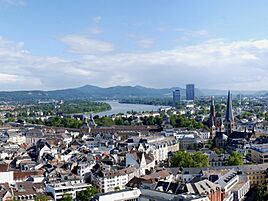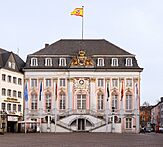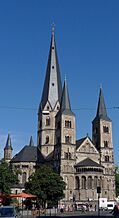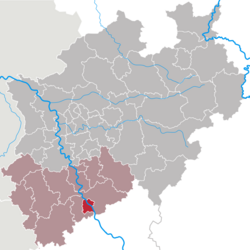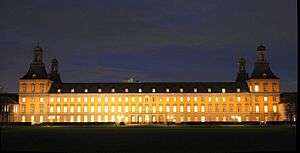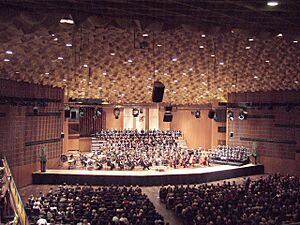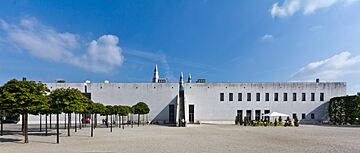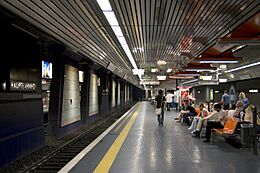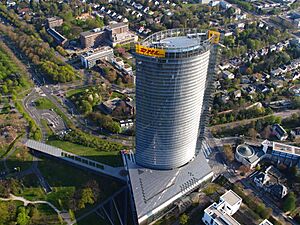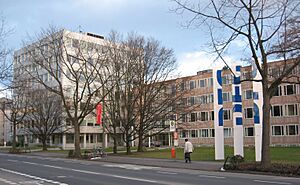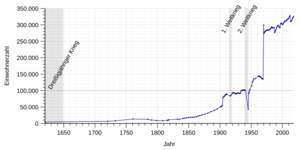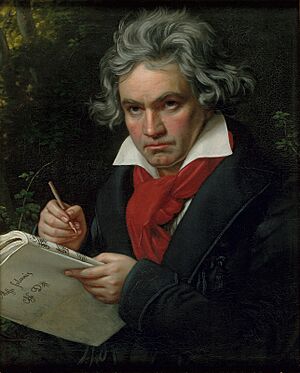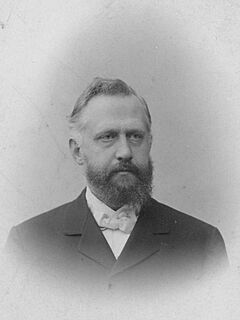Bonn facts for kids
Quick facts for kids
Bonn
|
|||
|---|---|---|---|
|
Federal city
|
|||
|
|
|||
|
|||
| Lua error in Module:Location_map at line 530: Unable to find the specified location map definition: "Module:Location map/data/Germany Nordrhein-Westfalen" does not exist. | |||
| Country | Germany | ||
| State | North Rhine-Westphalia | ||
| Admin. region | Cologne | ||
| District | Urban district | ||
| Founded | 1st century BC | ||
| Area | |||
| • Total | 141.06 km2 (54.46 sq mi) | ||
| Elevation | 60 m (200 ft) | ||
| Population
(2022-12-31)
|
|||
| • Total | 336,465 | ||
| • Density | 2,385.26/km2 (6,177.80/sq mi) | ||
| Time zone | UTC+01:00 (CET) | ||
| • Summer (DST) | UTC+02:00 (CEST) | ||
| Postal codes |
53111–53229
|
||
| Dialling codes | 0228 | ||
| Vehicle registration | BN | ||
Bonn is a special city in Germany, located in the state of North Rhine-Westphalia. It sits right on the Rhine River. More than 300,000 people live here! Bonn is about 24 kilometers (15 miles) south of Cologne. It's part of the Rhine-Ruhr region, which is Germany's largest metropolitan area. This big area has over 11 million people.
Bonn has a very important history. It was the capital of West Germany from 1949 until Germany became one country again in 1990. After that, it was the capital of reunited Germany until 1999, when the government moved back to Berlin. Bonn is also where Germany's current constitution, called the Basic Law, was created.
The city was founded way back in the 1st century BC by the Romans. This makes Bonn one of Germany's oldest cities. For a long time, from 1597 to 1794, it was the capital of the Electorate of Cologne. Even though Berlin is now the main capital, Bonn still has a big role in the German government. Many government jobs are still in Bonn, and it's sometimes called a "second capital." Bonn is known as a "Federal City" (Bundesstadt) because of its important political status.
Bonn is also home to big companies like Deutsche Post DHL and Deutsche Telekom. The famous University of Bonn is here, along with 20 United Nations offices. These include important groups working on climate change and fighting desertification. Plus, Bonn is the birthplace of the famous composer Ludwig van Beethoven. It's also a fun place for the Rhenish Carnival and a popular spot for tourists because of its beautiful location on the Middle Rhine.
Contents
Geography
Where is Bonn?
Bonn is in the southern part of the Rhine-Ruhr region, which is Germany's biggest metropolitan area. It's located in the German state of North Rhine-Westphalia, right next to the state of Rhineland-Palatinate. The city covers more than 141 square kilometers (54 square miles) on both sides of the Rhine River. Most of the city is on the left side of the river.
To the south and west, Bonn is close to the Eifel region, which has the Rhineland Nature Park. To the north, it borders the Cologne Lowland. Natural boundaries include the Sieg River to the northeast and the Siebengebirge (Seven Hills) to the east. The city is about 15 kilometers (9 miles) long from north to south and 12.5 kilometers (8 miles) wide from west to east.
How Bonn is Organized
The state of North Rhine-Westphalia is split into five governmental districts. Bonn is part of the governmental district of Cologne. Within this district, Bonn is its own special "urban district." This urban district is then divided into four main parts: Bonn, Bonn-Bad Godesberg, Bonn-Beuel, and Bonn-Hardtberg. In 1969, some nearby towns like Bad Godesberg and Beuel joined Bonn, making the city much larger than it was before.
Bonn's Weather
Bonn has an oceanic climate, which means it has mild temperatures. It's in the Rhine valley, making it one of Germany's warmer areas.
| Climate data for Bonn | |||||||||||||
|---|---|---|---|---|---|---|---|---|---|---|---|---|---|
| Month | Jan | Feb | Mar | Apr | May | Jun | Jul | Aug | Sep | Oct | Nov | Dec | Year |
| Mean daily maximum °C (°F) | 4.7 (40.5) |
6.1 (43.0) |
9.9 (49.8) |
14.1 (57.4) |
18.6 (65.5) |
21.8 (71.2) |
23.2 (73.8) |
22.8 (73.0) |
19.8 (67.6) |
14.7 (58.5) |
9.0 (48.2) |
5.8 (42.4) |
14.2 (57.6) |
| Daily mean °C (°F) | 2.4 (36.3) |
2.8 (37.0) |
6.3 (43.3) |
9.7 (49.5) |
14.0 (57.2) |
16.7 (62.1) |
18.8 (65.8) |
18.3 (64.9) |
14.6 (58.3) |
10.5 (50.9) |
6.2 (43.2) |
3.1 (37.6) |
10.3 (50.5) |
| Mean daily minimum °C (°F) | −0.6 (30.9) |
−0.4 (31.3) |
1.6 (34.9) |
4.5 (40.1) |
8.1 (46.6) |
11.3 (52.3) |
13.0 (55.4) |
12.5 (54.5) |
10.0 (50.0) |
6.4 (43.5) |
3.2 (37.8) |
0.6 (33.1) |
5.9 (42.5) |
| Average rainfall mm (inches) | 61.0 (2.40) |
54.0 (2.13) |
64.0 (2.52) |
54.0 (2.13) |
72.0 (2.83) |
86.0 (3.39) |
78.0 (3.07) |
78.0 (3.07) |
72.0 (2.83) |
63.0 (2.48) |
66.0 (2.60) |
68.0 (2.68) |
816.0 (32.13) |
| Mean monthly sunshine hours | 51.0 | 76.0 | 110.0 | 163.0 | 190.0 | 195.0 | 209.0 | 194.0 | 141.0 | 104.0 | 55.0 | 41.0 | 1,529 |
| Source 1: Deutscher Wetterdienst (Bonn-Rohleber, period 1971– 2010) | |||||||||||||
| Source 2: Climate-Data.org, high and low averages (altitude: 64m) | |||||||||||||
History
Bonn's Roman Beginnings
Bonn's history goes back to the time of the Roman Empire. Around 12 BC, the Roman army set up a small camp here. Even before that, the Romans had settled a Germanic tribe called the Ubii in the area. The Latin name "Bonna" might come from the original people who lived here, the Eburones.
Later, in the 1st century AD, the Romans built a huge military fort called Castra Bonnensis (Fort Bonn). This fort was made of wood at first, then rebuilt with stone. It was used by the Roman army until the mid-5th century. The fort was so big it could hold a full Roman legion (a large army unit) and its helpers. It covered about 250,000 square meters (62 acres)! Inside, it had many streets and buildings, like headquarters, officers' quarters, and barracks.
A main Roman road connecting important cities like Cologne and Mainz went right through the fort. A local town, also called Bonna, grew up along this road. Later, much of the Roman town was destroyed by invaders. The people who remained moved inside the fort for safety. From this fort, and a new settlement around what became the Bonn Minster, the medieval city of Bonn grew. The Sterntor (star gate) in the city center today is a reconstruction using parts of the old medieval city wall.
From Middle Ages to Modern Times
Between the 11th and 13th centuries, the beautiful Romanesque style Bonn Minster church was built. In 1597, Bonn became the main city for the Archdiocese of Cologne. This made the city more important and it grew a lot.
In 1794, French troops took over Bonn, and it became part of the First French Empire. After the Napoleonic Wars in 1815, Bonn became part of the Kingdom of Prussia. It wasn't a very important city during these years.
Bonn as Germany's Capital (The "Bonn Republic")
After World War II, Bonn was in the British zone of Germany. In 1949, when West Germany was formed, Bonn became its capital. It was called the "temporary seat of the Federal institutions." Even though Berlin was officially the capital of Germany, Bonn was chosen as the temporary capital. This was because leaders like Konrad Adenauer wanted Berlin to be the capital of a reunited Germany someday. They felt that choosing a big city like Frankfurt as a permanent capital might make people forget about reuniting Germany.
In 1949, the German constitution, the Basic Law for the Federal Republic of Germany, was written and approved in Bonn. Bonn was the political center of West Germany for many years. This time is often called the Bonn Republic.
After Germany Reunited

When Germany reunited in 1990, Berlin became the official capital again. But there was a big discussion about whether the government offices should move to Berlin or stay in Bonn. Some people wanted the government to move to Berlin because it was the historic capital. Others wanted it to stay in Bonn because it was closer to important European organizations.
Finally, in 1991, the German parliament voted to move the main government offices to Berlin. The vote was very close! Even so, Bonn still has a special role. It's called the "Federal City" (Bundesstadt). The President and Chancellor still have offices in Bonn. Many government ministries, like the Ministry of Food & Agriculture and the Ministry of Defence, also have large offices here. More than 8,000 federal officials still work in Bonn. Also, 19 United Nations (UN) organizations have offices in Bonn today.
Culture
Bonn has many interesting places to visit! Beethoven's birthplace is located near the market square. Next to the market is the Old City Hall, built in 1737 in the beautiful Rococo style. It's used for special events and as the mayor's office.
The Kurfürstliches Schloss was once a home for important rulers and is now the main building of the University of Bonn. The Poppelsdorfer Allee is a lovely street lined with Chestnut trees. It connects the Kurfürstliches Schloss with the Poppelsdorfer Schloss, another palace that is now a botanical garden.
The Beethoven Monument stands in Münsterplatz, a square next to the Bonn Minster. This church is one of Germany's oldest. The tallest buildings in Bonn include the Post Tower (162.5 meters or 533 feet tall), which is the headquarters of Deutsche Post, and the Langer Eugen (114.7 meters or 376 feet tall), which is now the United Nations Campus.
Churches and Castles
- Bonn Minster: One of Germany's oldest churches.
- Doppelkirche Schwarzrheindorf: A unique church built in 1151.
- Old Cemetery Bonn: A famous cemetery in Germany.
- Kreuzbergkirche: A church built in 1627 with a special stairway for Christian pilgrims.
- St. Remigius: The church where Beethoven was baptized.
- Godesburg fortress ruins: The remains of an old castle.
Modern Buildings
- Beethovenhalle: A concert hall.
- Bundesviertel (federal quarter): This area has many government buildings, including:
- Post Tower: The tallest building in the state of North Rhine-Westphalia.
- Schürmann-Bau: Headquarters of Deutsche Welle, a German international broadcaster.
- Langer Eugen: Now the center of the United Nations Campus.
- Deutsche Telekom headquarters: Another major company building.
- Kameha Grand: A fancy hotel.
Museums
Bonn has a "Museum Mile" with five major museums.
- Haus der Geschichte (Museum of the History of the Federal Republic of Germany): This museum shows German history from 1945 until today, including Bonn's role as the former capital.
- Kunstmuseum Bonn (Bonn Museum of Modern Art): This art museum has modern German art, especially from the Expressionism movement. It has one of the largest collections of art by August Macke.
- Bundeskunsthalle (Art and Exhibition Hall of the Federal Republic of Germany): This museum focuses on culture, arts, and science from around the world.
- Museum Koenig: Bonn's natural history museum, with many animals and scientific research. It's also where Germany's first parliament met!
- Deutsches Museum Bonn: A science museum that shows German scientists, engineers, and inventions from after World War II.
Other museums include the Beethoven House, the Rheinisches Landesmuseum Bonn (Rhinish Regional Museum), and the Bonn Women's Museum.
Nature and Parks
Bonn has many beautiful parks and natural areas.
- Rheinaue: This is Bonn's most important park, like a big playground for the city. It's on the banks of the Rhine River.
- The Rhine promenade and the Alter Zoll (Old Toll Station) are popular spots near the city center.
- The Arboretum Park Härle is a garden with special trees, some dating back to 1870.
- The Botanischer Garten (Botanical Garden) is connected to the university.
- The Kottenforst is a large protected forest area west of the city.
- To the south, there's an old volcano called the Rodderberg, which is great for hikes.
- The Siebengebirge (Seven Hills) are also south of the city, part of the beautiful Middle Rhine region.
Transportation
Getting to Bonn by Air
The Cologne Bonn Airport is about 15 kilometers (9 miles) northeast of Bonn's city center. It's named after Konrad Adenauer, West Germany's first leader. In 2015, over 10 million passengers used this airport. It's one of Germany's busiest airports for both passengers and cargo. The airport is open 24 hours a day and is a hub for airlines like Eurowings.
You can reach the airport from Bonn by the A59 motorway or by train. Another big airport, Düsseldorf Airport, is also about an hour's drive away.
Trains and Buses
Bonn Hauptbahnhof (Bonn Central Station) is the city's main public transport hub. It's close to the old town and the university. Many regional and long-distance trains stop here. Over 67,000 people use this station every day! You can also take a train from Bonn to Siegburg/Bonn station for faster connections to Southern Germany.
Bonn has a light rail (Stadtbahn) and a tram system. The Stadtbahn connects the city center to areas like Bad Godesberg and Beuel, and even to nearby towns and Cologne. The tram lines connect closer parts of Bonn to the Central Station. There's also a bus system with about 30 lines, covering areas not reached by the trains or trams. All public transport in Bonn is part of the Verkehrsverbund Rhein-Sieg (Rhine-Sieg Transport Association).
Roads and Bridges
Four major motorways (Autobahns) run through or near Bonn: the A59, A555, A562, and A565. These connect Bonn to other major cities like Düsseldorf and Cologne.
Since the Rhine River divides Bonn, three important bridges help traffic move around the city: the Konrad-Adenauer-Brücke, the Friedrich-Ebert-Brücke, and the Kennedybrücke. There are also ferries that cross the Rhine.
Port
Bonn has an inland harbor in the northern part of the city. It's used for shipping containers and other goods. About 500,000 tons of goods pass through the port each year. You can also take passenger boats from Bonn to Cologne and Düsseldorf.
Economy
Many big companies have their main offices in Bonn. These include Deutsche Telekom, its part T-Mobile, and Deutsche Post. The German Academic Exchange Service, which helps students study abroad, also has its offices here.
The University of Bonn and its clinics are one of the biggest employers in the city. Other important employers include Stadtwerke Bonn, which provides city services.
Bonn is also home to some well-known traditional companies. For example, Verpoorten makes luxury foods, and Haribo, famous for its gummy bears, was founded in Bonn in 1920. Although Haribo's main office moved in 2018, it still has a production site in Bonn.
Education
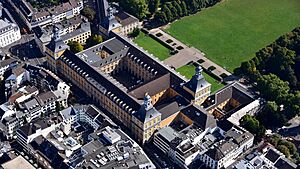
The University of Bonn (Rheinische Friedrich Wilhelms Universität Bonn) is one of the largest universities in Germany. It's also where the offices of the Deutsche Forschungsgemeinschaft (DFG), a big research funding organization, and the German Academic Exchange Service (DAAD) are located.
Private Schools
Bonn has several private schools, including:
- Aloisiuskolleg: A Jesuit private school in Bad Godesberg.
- Bonn International School (BIS): An English-speaking school for students from kindergarten to 12th grade.
- Independent Bonn International School (IBIS): A private primary school.
- École de Gaulle - Adenauer: A private French-speaking school.
- Kardinal-Frings-Gymnasium (KFG): A private Catholic school in Beuel.
- Liebfrauenschule (LFS): Another private Catholic school.
Demographics
As of 2011, Bonn had a population of 327,913 people. About 70% of the people were of German origin. Around 100,000 people, or about 30%, had roots from other countries. Bonn is one of the fastest-growing cities in Germany and the 18th most populated city in the country. It's expected that Bonn's population will grow even more in the coming years.
Bonn is a diverse city, with people from many different backgrounds. Here are some of the largest groups of people with family roots from other countries, as of 2022:
| Rank | Migration background | Population (31 December 2022) |
|---|---|---|
| 1 | 9,428 | |
| 2 | 8,254 | |
| 3 | 6,879 | |
| 4 | 5,921 | |
| 5 | 3,976 | |
| 6 | 3,933 | |
| 7 | 3,341 | |
| 8 | 3,282 | |
| 9 | 2,744 | |
| 10 | 2,429 |
Sports
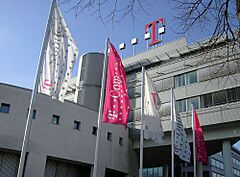
Bonn is home to the Telekom Baskets Bonn, a professional basketball team. They are the only basketball club in Germany that owns its own arena, the Telekom Dome. They even won the 2022–23 Basketball Champions League recently!
The city also has a football (soccer) team called Bonner SC. For baseball fans, the successful Bonn Capitals team is also in Bonn. The main office for the International Paralympic Committee, which organizes sports for athletes with disabilities, has been in Bonn since 1999.
International Relations
Bonn has many international connections with cities around the world. Since 1983, Bonn has been friends with Tel Aviv, Israel. Since 1988, it has a partnership with Potsdam, another important German city.
Many of Bonn's city districts also have their own partnerships with towns in other countries:
- The city district of Bonn is partners with Oxford, England (since 1947), Budafok, Hungary (since 1991), and Opole, Poland (since 1997).
- The district of Bad Godesberg has partnerships with Saint-Cloud in France, Frascati in Italy, Windsor and Maidenhead in England, and Kortrijk in Belgium. It also has a friendship agreement with Yalova, Turkey.
- The districts of Beuel and Hardtberg have partnerships with towns in France: Mirecourt and Villemomble.
Bonn also works with other cities on projects focused on sustainability. These include Minsk in Belarus, Ulaanbaatar in Mongolia, Bukhara in Uzbekistan, Chengdu in China, and La Paz in Bolivia.
Twin towns – sister cities
Bonn is twinned with:
 Bukhara, Uzbekistan (1999)
Bukhara, Uzbekistan (1999) Cape Coast, Ghana (2012)
Cape Coast, Ghana (2012) Chengdu, China (2009)
Chengdu, China (2009) Kherson, Ukraine (2023)
Kherson, Ukraine (2023) Minsk, Belarus (1993)
Minsk, Belarus (1993) La Paz, Bolivia (1996)
La Paz, Bolivia (1996) Potsdam, Germany (1988)
Potsdam, Germany (1988)
 Tel Aviv, Israel (1983)
Tel Aviv, Israel (1983) Ulaanbaatar, Mongolia (1993)
Ulaanbaatar, Mongolia (1993)
Bonn city district is twinned with:
 Oxford, United Kingdom (1947)
Oxford, United Kingdom (1947) Budafok-Tétény (Budapest), Hungary (1991)
Budafok-Tétény (Budapest), Hungary (1991)
For twin towns of other city districts, see Bad Godesberg, Beuel and Hardtberg.
Notable People
Many interesting people were born or lived in Bonn:
- Johann Peter Salomon (1745–1815), a musician.
- Ludwig van Beethoven (1770–1827), a world-famous composer.
- Peter Joseph Lenné (1789–1866), a famous gardener and landscape architect.
- Johanna Kinkel (1810–1858), a composer and writer.
- Alexander Koenig (1858–1940), a zoologist who founded the Museum Koenig in Bonn.
- Hans Riegel Sr. (1893–1945), the person who started the company Haribo.
- Heide Simonis (1943–2023), a politician who was a former Prime Minister.
- Roswitha Esser (born 1941), a canoeist who won gold medals at the Olympic Games.
- Thomas de Maizière (born 1954), a politician.
- Gerd Faltings (born 1954), a mathematician who won the Fields Medal.
- Guido Westerwelle (1961–2016), a politician who was a Foreign Minister.
- Johannes B. Kerner (born 1964), a TV presenter.
- Sonja Zietlow (born 1968), a TV presenter.
- Sabriye Tenberken (born 1970), who founded an organization called Braille Without Borders.
- Kim Petras (born 1992), a pop singer and songwriter.
- Pius Heinz (born 1989), a poker player who won the World Series of Poker.
- Konstanze Klosterhalfen (born 1997), a track and field athlete.
- Anny Ogrezeanu (born 2001), a singer who won The Voice of Germany.
Images for kids
See also
 In Spanish: Bonn para niños
In Spanish: Bonn para niños


